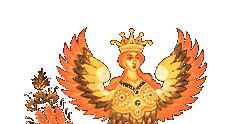Pavel Bazhov's collection of tales includes, "The Tale of the Stone Flower." In it a man, Danilo, embarks on an artistic quest to find the secrets in carving the perfect stone flower. Katya, his wife who he leaves behind, also embarks on a quest to find her husband. Many think he is dead, but in her heart she knows that her feelings will guide her to him.
Danilo's quest took him through lands many traveled days and night away from home to the Copper Mountain. In it lives an entity in the form of a woman called the Mistress of Copper Mountain. Danilo meets this mysterious and beautiful being who shows him her collection of stone flowers. As he marvels at them she tells him that she can teach him this art and as he agrees his mind is swept away. From this point forward his home is this mountain cave and all earthly influences are of no consequence anymore. He completely forgets about his wife, which is not his fault because he was under the magical influence of the mountain's mistress.
Then it was up to Katya to bring her husband back. Although it was one of the best things that could have happened to the young craftsman, it was also time for him to go. His skill had exceeded all the skill of all the other master sculptors in the world combined. When Katya found him she had to convince the mistress to let him go, and when she expressed that it was true love that got her to the mountain the mistress let Danilo out of his trance.
When Danilo returned to his village he set up a workshop where he sold his carved flowers. They were so life-like and vivid that they seemed to be fresh cut flowers from the fields. He and Katya had many children all of whom were taught the intricate techniques that the Mistress of Copper Mountain taught Danilo in the mountain cave.
Sergey Prokofiev wrote the ballet the Stone Flower based on Bazhov's tale in 1953. He started the work in 1948 finishing it five years later, and it became his final ballet. Prokofiev's influence was widespread. Being one of the most famous composers in early Soviet Russia, he was public in criticizing and even doing a parody on the October Revolution called appropriately the "October Canata," during Stalin's reign.
The orchestration consists of 2 flutes, piccolo, 2 oboes, english horn, 2 clarinets, E-flat clarinet, bass clarinet, 2 bassoons, contrabassoon, 4 horns, 3 trumpets, 3 trombones, tuba, timpani, percussion (triangle, castanets, wood blocks, tambourine, snare drum, cymbals, bass drum, tam-tam, tubular bells, xylophone), harp, piano, and strings.
It premeired on February 12th 1954 at Moscow's Bolshoi Theater. Only two recordings of the complete ballet are known to exist -- the famous Rozhdestvensky recording with the Bolshoi Theater Orchestra from 1968, and Michail Jurowski's recording with the Hannover Radio Philharmonic from 1995 and 1997. To be techincally correct, only Jurowski's is complete on CD -- the Russian Disc two-disc release of Rozhdestvensky's 1968 recording is abridged by a few numbers. Between the two recordings, Jurowski's is the preferred. His reading is much more patient where Rozhdestvenky is consistently brisk. Jurowski takes the time to illuminate Prokofiev's lush melodies and masterful orchestration. The Hannover musicians also play with exquisite skill. Rozhdestvensky's recording is exciting and urgent, but suffers by comparison in two important ways -- the recording quality is dreadful and the tempi are too fast in many passages. If you grew up on the Rozhdestvensky recording, Jurowski's interpretation will recast the work in an entirely new light. His is an inspired performance that will hopefully reignite interest in this neglected masterpiece.
|



